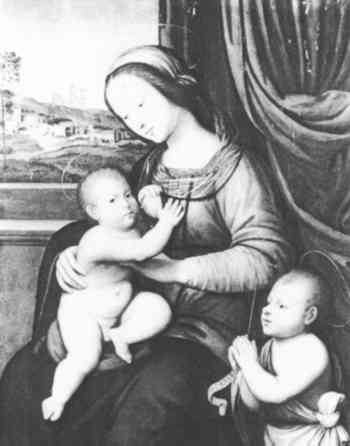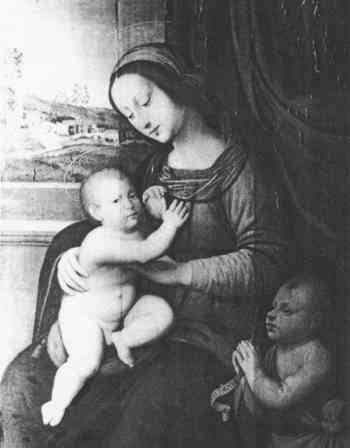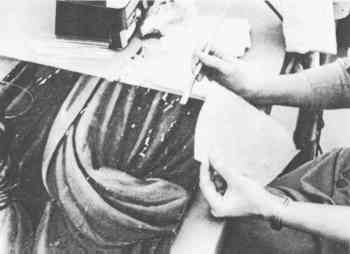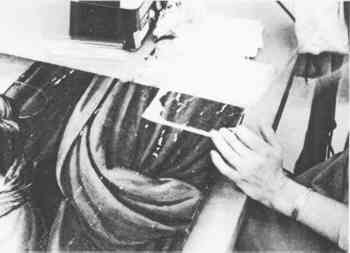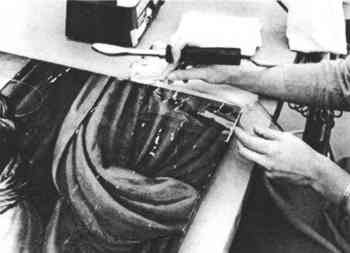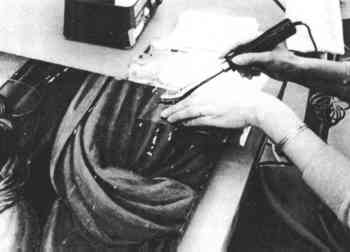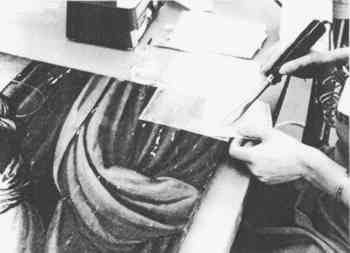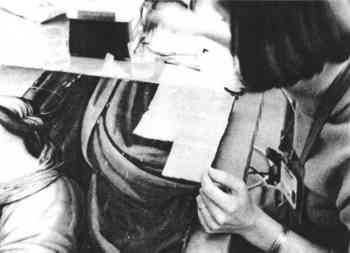STURGEON GLUE FOR PAINTING CONSOLIDATION IN RUSSIATATYANA PETUKHOVA, & STEPHEN D. BONADIES
2 STURGEON GLUEUnlike fish glue, which is prepared from the waste products (heads, trimmings, and bones), the best sturgeon glue is prepared by using only the inner membrane of the air bladder of the sturgeon. The sevryuga (Acipenser stellatus) and the os�tr (A. g�ldenst�dtii) yield the best “Russian isinglass” (Isinglass 1941). The color is milky white. Other varieties of fish yield “Brazilian isinglass” and “Penang” which are darker in color and less soluble than the Russian product. The finest sturgeon glue is prepared by washing the bladders in hot water to remove extraneous material. The bladders are then cut open to expose the inner membrane to air. When almost dry, the outer membrane is removed by rubbing and beating. In commerce, the principle use of sturgeon glue is to clarify wines, beers, and other liquids. This property has been attributed to the fibrous structure of the material. 2.1 PREPARATION OF STURGEON GLUE STOCK SOLUTIONThe glue solution is prepared by placing an appropriate amount of the dried sturgeon glue in a glass beaker or an enameled pot. Just enough water to cover the glue pieces is The temperature should slowly be raised to 60�C with continuous stirring until the glue is just dissolved (the time necessary to dissolve the glue will depend on the quantity being prepared). Care must be used not to overheat the solution. If the solution is overheated at this point or at any time during its reheating prior to use, it will become granular and the glue will lose much of its tackiness. The solution must then be discarded and a fresh solution prepared. Once the glue has dissolved, it is removed from the heat and strained through cheesecloth if necessary. A preservative can be added at this point; in practice, however, the authors have found that it is better to prepare only the quantity needed for immediate use. Extra stock solution can be kept for several days if refrigerated at 5–6�C, but a fresh solution is better. The final chilled solution will gel. The stock solution can then be diluted to the appropriate concentration depending upon its use. If a plasticizer is necessary, Russian conservation practice is to add dark wild-flower honey to the glue solution, usually in a proportion equal to the weight of the dry glue. The authors have experimented with various plasticizers, such as glycerine, propylene glycol, and others; these substances, require further investigation. 2.2 CONSOLIDATION AND RELAXATION OF PAINTTo best illustrate the process of consolidation with sturgeon glue the authors chose a 16th-century panel painting by Antonio del Ceraiolo Madonna and Child with the Infant Saint John the Baptist(figs. 1–2). The painting exhibited severe tented cleavage, especially in the upper right quadrant along the grain of the support (fig. 3). A major concern in reattaching the paint and ground layers was to avoid the overlapping of adjacent flakes of paint due to dimensional changes in the support. While other, more readily available products such as animal gelatin or rabbit-skin glue could have been successfully used, Russian experience has shown that the use of sturgeon glue, especially with the addition of small amounts of solvents (see below), results in a more flexible and thus more malleable paint layer. For this reason sturgeon glue was determined to be the appropriate consolidant and was used with a remarkable degree of success (fig. 4).
A 5–6% (w/v, dry weight to water) solution of sturgeon glue was prepared. The variation depends on the source of the dry glue. To decrease the surface tension and improve penetration, approximately 1 ml of 1:1 (v/v) ethanol/distilled water solution is first brushed on the area to be consolidated. Pinene (turpenoid, C10H16, BP 156�C) or xylene, added directly to the glue solution in the proportions 1 part solvent to 20 parts glue, can also be added. Solvents tend to be used more often with paintings on canvas supports. The glue/solvent mixture should be prepared immediately before each use because of the rapid evaporation of the solvents. If one of the above solvents is not added to the glue solution, the flexibility of the paint and ground will be increased only after prolonged ironing. Research has shown that paint layers react differently to different methods of consolidation (Gorin and Cherkasova 1977). In both cases (with and without the addition of solvents) the paint and ground layers will swell evenly in all directions. With the addition of solvent, however, the swelling reaction occurs more quickly and thus greatly aids in the relaxation of severely tented paint. In the treatment of the Ceraiolo Madonna, consolidation was achieved by working locally in small areas approximately 12 � 17 cm. Each area was pretreated by flowing 1:1 (v/v) ethanol/distilled water along the cleaved paint and into the adjacent cracks. Immediately afterwards the warm sturgeon glue solution (60�C) was applied to the same area. Then the entire area was covered with one layer of Japanese tissue (figs. 5–6). If applying the warm glue by brush seemed likely to disturb the damaged paint, the Japanese tissue was placed on the area to be consolidated prior to any application of the glue solution. More glue was applied generously through the tissue until it was completely saturated. The area was then covered with a sheet of heavy-weight polyester film (Mylar) and gently ironed with a warm iron (the temperature should not exceed 80�C) until the paint relaxed and returned to plane (figs. 7–8). The degree of relaxation was checked frequently by touching the surface with a finger.
After a satisfactory degree of relaxation had been achieved, the polyester film was carefully removed and one or two layers of Japanese tissue and one layer of scrap bond paper (scrap computer paper worked well) were added to the area just treated to help absorb excess moisture. Gentle ironing was continued with frequent changing of the bond paper until the area was dry (figs. 9–10). If the paint had been particularly difficult to relax after usual consolidation, blotting paper and weights could be placed on the surface and left overnight. This step was not found to be necessary due to the ready response of the paint to the consolidating solution.
Once a treated area had dried overnight, the layers of Japanese tissue were easily removed with a slight amount of warm moisture. The consolidation process can be repeated if the degree of relaxation is not sufficient. If the varnish has blanched, the proportion of solvent added to the glue can be altered to remedy this situation. In general, although consolidation can be carried out prior to cleaning, as was done with the Ceraiolo painting, the authors found it necessary to repeat the consolidation on some areas after the varnish had been reduced during cleaning, since an especially thick layer of varnish had initially inhibited thorough penetration of the glue solution. |
